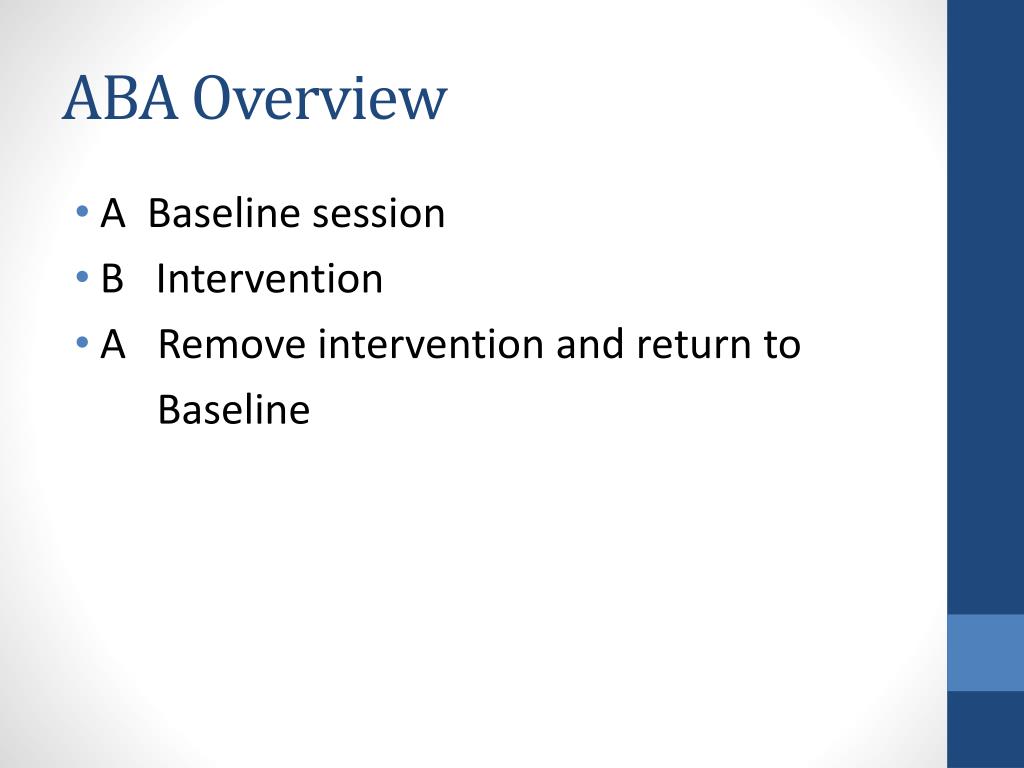Table Of Content

We also describe how SCDs can address other features of optimization, which include establishing generality and enabling personalized behavioral medicine. Throughout, we highlight how SCDs can be used during both the development and dissemination stages of behavioral health interventions. Single-subject research, by contrast, relies heavily on a very different approach called visual inspection.
General Features of Single-Subject Designs
Again, the researcher waits until that dependent variable reaches a steady state so that it is clear whether and how much it has changed. Finally, the researcher removes the treatment and again waits until the dependent variable reaches a steady state. This basic reversal design can also be extended with the reintroduction of the treatment (ABAB), another return to baseline (ABABA), and so on.

Steps for Setting Up an ABA Practice
It has been linked to improvements in key areas including language, social skills, and adaptive skills. This type of treatment may focus on helping an individual in a specific situation where they are facing difficulty. The individual often works one-on-one with a therapist, but they may also practice these skills in small groups or in community settings. We are now in a position to evaluate whether SCDs live up to our ideals about optimization.
Setting up an ABA Practice
The utility of these designs is derived from demonstrating that change occurs when, and only when, the intervention is directed at a particular participant (or whatever the unit of analysis happens to be [28]). The influence of other factors, such as idiosyncratic experiences of the individual or self-monitoring (e.g., reactivity), can be ruled out by replicating the effect across multiple individuals. A key to ruling out extraneous factors is a stable enough baseline phase (either no trends or a trend in the opposite direction to the treatment effect). As replications are observed across individuals, and behavior changes when and only when treatment is introduced, confidence that behavior change was caused by the treatment increases. In a reversal design, a treatment is introduced after the baseline period, and then a baseline period is re-introduced, hence, the “reversal” in this design (also known as an ABA design, where “A” is baseline and “B” is treatment).
Focus Areas of Behavior Intervention
If two components produce equal changes in behavior, and the same amount of change when both are combined, then either component is sufficient but neither is necessary. Over the past 70 years, single-case design (SCD) research has evolved to include a broad array of methodological and analytic advances. In this article, we describe some of these advances and discuss how SCDs can be used to optimize behavioral health interventions. Specifically, we discuss how parametric analysis, component analysis, and systematic replications can be used to optimize interventions.

The step counts for all six participants increased reliably with each increase in the goals, thereby demonstrating experimental control of the intervention. This design has many of the same benefits of the multiple-baseline design, namely that a reversal is not required for ethical or potentially practical reasons (i.e., irreversible treatment effects). There are two potential limitations of reversal designs in the context of behavioral health interventions. However, we think that the benefits of demonstrating that a treatment works outweigh the risks of temporarily withdrawing treatment (in most cases). The treatment can also be re-instituted in a reversal design (i.e., an ABAB design).
They were interested in how a school-wide bullying prevention program affected the bullying behavior of particular problem students. At each of three different schools, the researchers studied two students who had regularly engaged in bullying. During the baseline phase, they observed the students for 10-minute periods each day during lunch recess and counted the number of aggressive behaviors they exhibited toward their peers. (The researchers used handheld computers to help record the data.) After 2 weeks, they implemented the program at one school. They found that the number of aggressive behaviors exhibited by each student dropped shortly after the program was implemented at his or her school.
How ABA Therapy Works
This research method yields a high amount of data that can be analyzed by researchers. This data can then be used to support a researchers hypothesis and/or give insight before moving on to a group research project. He researches the topic and consults with his mentor to discover three possible interventions that are sound and feasible. He decides to conduct a multi-element design where he alternates the treatments and evaluate how his learner responds to each version of the intervention in terms of eating. Whichever intervention produces the most food consumed will be the intervention that Tim continues to use. Janet, a BCBA and SPED teacher observed that her student struggled with achieving the correct pencil grip while writing.
Experimental control is demonstrated by the repeated changes in the dependent variable with each successive introduction of the independent variable. It protects against the inability of AB - type designs to demonstrate unequivocal control by the independent variable by showing the effects at different times. It is unlikely that a confound could repeatedly coincide with the introduction of the experimental variable.
The effect of an independent variable is easier to detect when the “noise” in the data is minimized. Several conclusions can be drawn about the effects of the various components in changing behavior. The data should first be evaluated to determine the extent to which the effects of individual components are independent of one another. If they are not, then the effects are multiplicative, or the effects of one component depend on the presence of another component.
In the context of single-case research, generality can be demonstrated experimentally in several ways. Direct replication means conducting the same experiment on the same behavioral problem across several individuals (i.e., a single-case experiment). For example, Raiff and Dallery [72] achieved a direct replication of the effects of internet-based contingency management (CM) on adherence to glucose testing in four adolescents.

No comments:
Post a Comment